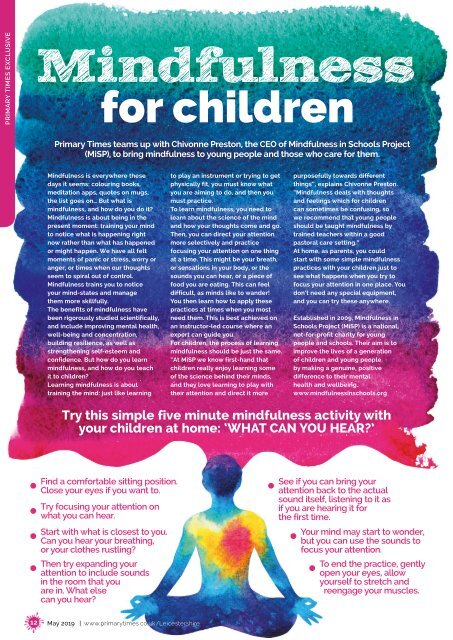Primary Times Leicestershire May edition
You also want an ePaper? Increase the reach of your titles
YUMPU automatically turns print PDFs into web optimized ePapers that Google loves.
PRIMARY TIMES EXCLUSIVE<br />
Mindfulness<br />
for children<br />
<strong>Primary</strong> <strong>Times</strong> teams up with Chivonne Preston, the CEO of Mindfulness in Schools Project<br />
(MiSP), to bring mindfulness to young people and those who care for them.<br />
Mindfulness is everywhere these<br />
days it seems: colouring books,<br />
meditation apps, quotes on mugs,<br />
the list goes on… But what is<br />
mindfulness, and how do you do it?<br />
Mindfulness is about being in the<br />
present moment: training your mind<br />
to notice what is happening right<br />
now rather than what has happened<br />
or might happen. We have all felt<br />
moments of panic or stress, worry or<br />
anger, or times when our thoughts<br />
seem to spiral out of control.<br />
Mindfulness trains you to notice<br />
your mind-states and manage<br />
them more skillfully.<br />
The benefits of mindfulness have<br />
been rigorously studied scientifically,<br />
and include improving mental health,<br />
well-being and concentration,<br />
building resilience, as well as<br />
strengthening self-esteem and<br />
confidence. But how do you learn<br />
mindfulness, and how do you teach<br />
it to children?<br />
Learning mindfulness is about<br />
training the mind: just like learning<br />
to play an instrument or trying to get<br />
physically fit, you must know what<br />
you are aiming to do, and then you<br />
must practice.<br />
To learn mindfulness, you need to<br />
learn about the science of the mind<br />
and how your thoughts come and go.<br />
Then, you can direct your attention<br />
more selectively and practice<br />
focusing your attention on one thing<br />
at a time. This might be your breath,<br />
or sensations in your body, or the<br />
sounds you can hear, or a piece of<br />
food you are eating. This can feel<br />
difficult, as minds like to wander!<br />
You then learn how to apply these<br />
practices at times when you most<br />
need them. This is best achieved on<br />
an instructor-led course where an<br />
expert can guide you.<br />
For children, the process of learning<br />
mindfulness should be just the same.<br />
“At MiSP we know first-hand that<br />
children really enjoy learning some<br />
of the science behind their minds,<br />
and they love learning to play with<br />
their attention and direct it more<br />
purposefully towards different<br />
things”, explains Chivonne Preston.<br />
“Mindfulness deals with thoughts<br />
and feelings which for children<br />
can sometimes be confusing, so<br />
we recommend that young people<br />
should be taught mindfulness by<br />
trained teachers within a good<br />
pastoral care setting.”<br />
At home, as parents, you could<br />
start with some simple mindfulness<br />
practices with your children just to<br />
see what happens when you try to<br />
focus your attention in one place. You<br />
don’t need any special equipment,<br />
and you can try these anywhere.<br />
Established in 2009, Mindfulness in<br />
Schools Project (MiSP) is a national,<br />
not-for-profit charity for young<br />
people and schools. Their aim is to<br />
improve the lives of a generation<br />
of children and young people<br />
by making a genuine, positive<br />
difference to their mental<br />
health and wellbeing.<br />
www.mindfulnessinschools.org<br />
Try this simple five minute mindfulness activity with<br />
your children at home: ‘WHAT CAN YOU HEAR?’<br />
Find a comfortable sitting position.<br />
Close your eyes if you want to.<br />
Try focusing your attention on<br />
what you can hear.<br />
Start with what is closest to you.<br />
Can you hear your breathing,<br />
or your clothes rustling?<br />
Then try expanding your<br />
attention to include sounds<br />
in the room that you<br />
are in. What else<br />
can you hear?<br />
See if you can bring your<br />
attention back to the actual<br />
sound itself, listening to it as<br />
if you are hearing it for<br />
the first time.<br />
Your mind may start to wonder,<br />
but you can use the sounds to<br />
focus your attention.<br />
To end the practice, gently<br />
open your eyes, allow<br />
yourself to stretch and<br />
reengage your muscles.<br />
12<br />
<strong>May</strong> 2019 | www.primarytimes.co.uk/<strong>Leicestershire</strong>

















